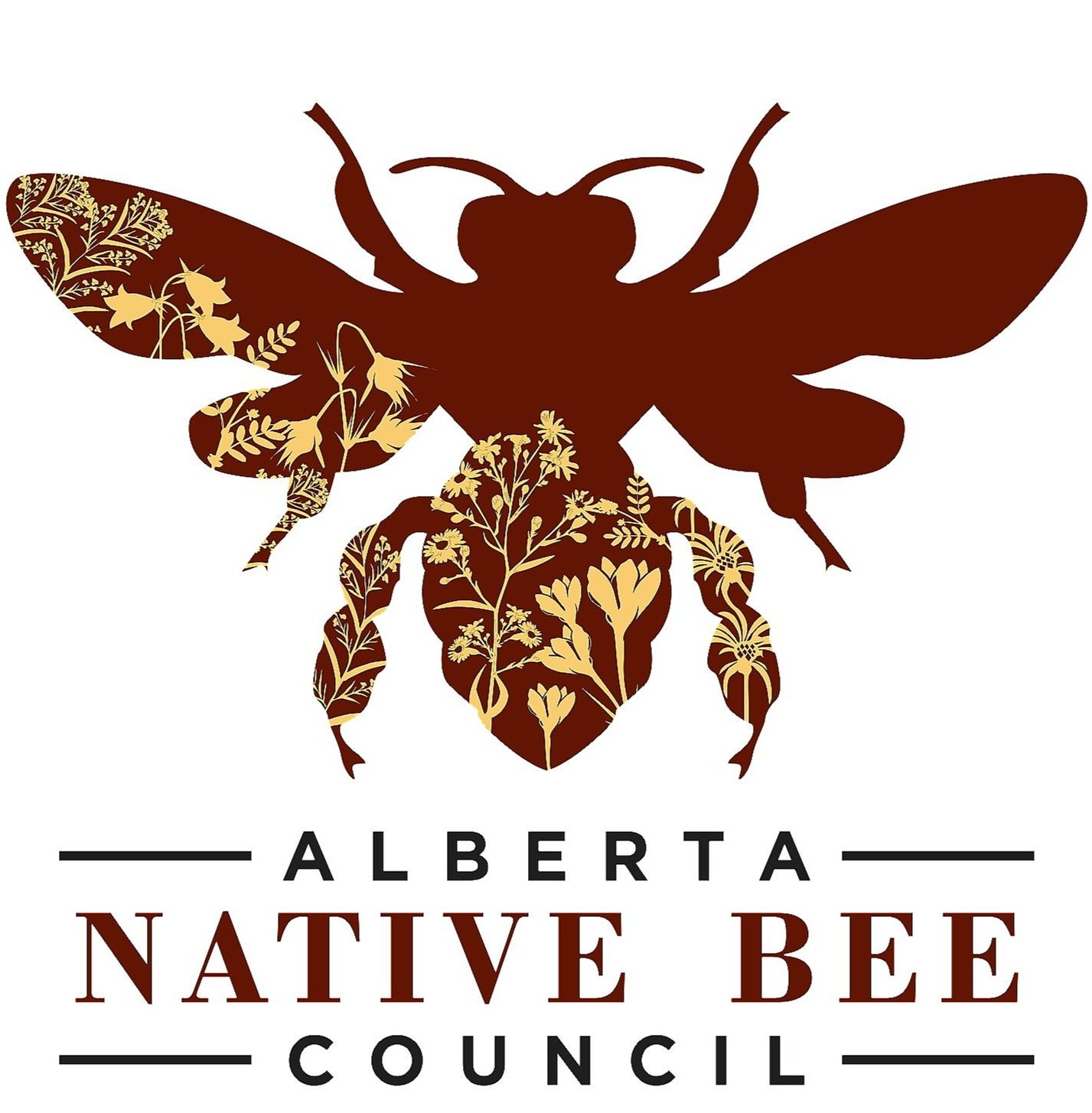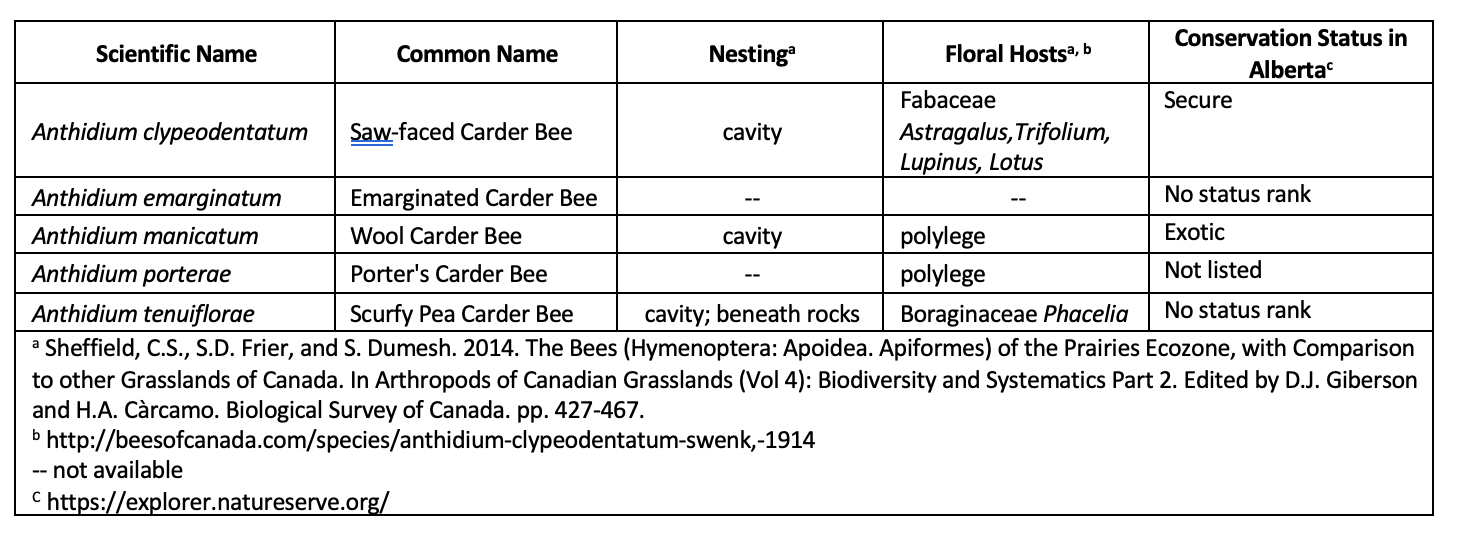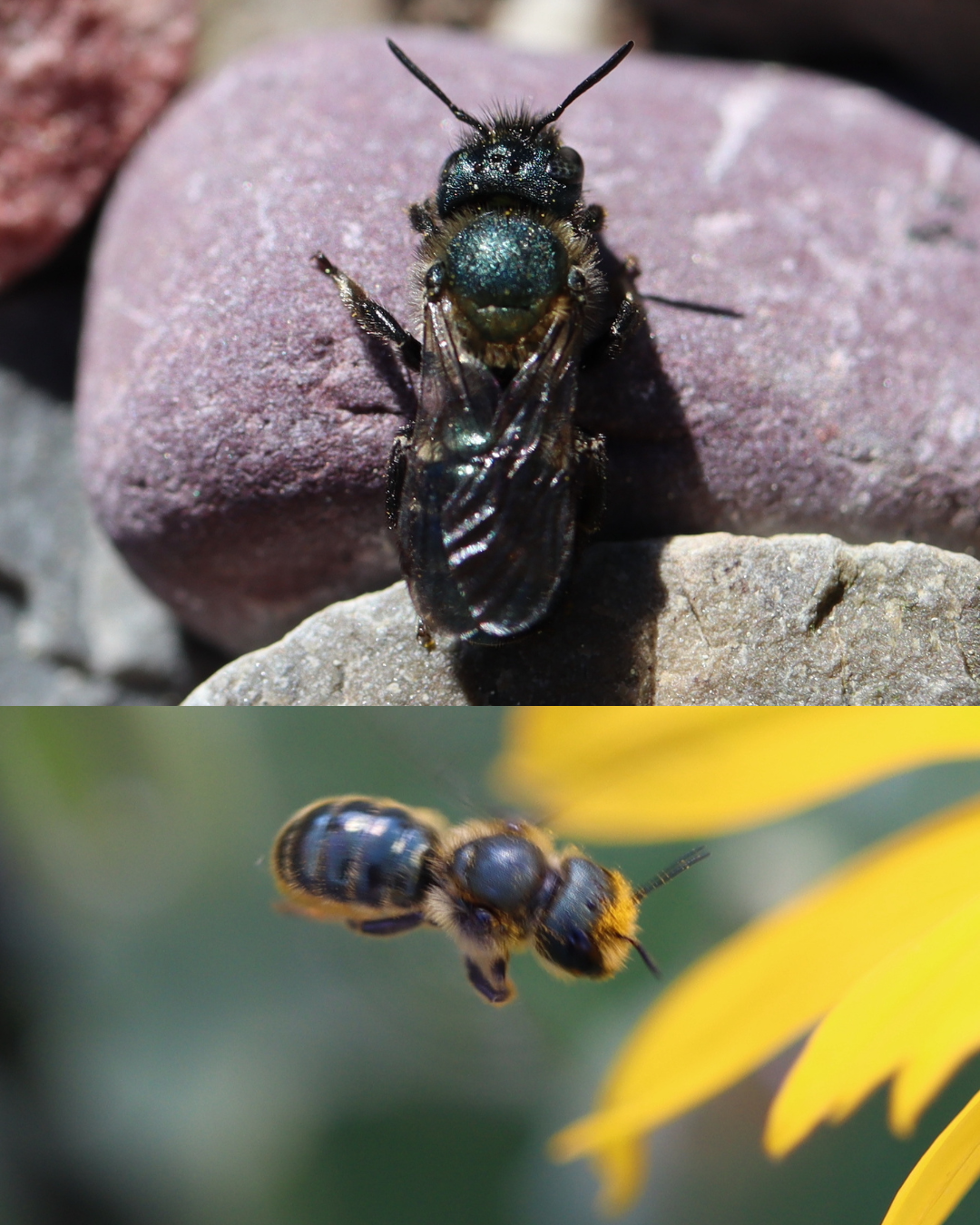
Megachilidae
Megachilidae (Mason and Leaf Cutter Bees)
Of the 178 species of bees in the Megachilidae family found in Canada, 75 of them occur in Alberta.
Bees in the Megachilidae family build their nest cells from soil (mason bees) or leaves (leaf cutter bees). A few collect plant or animal hairs and fibres to construct nest cells and are called carder bees. Most species nest in holes in wood or hollow twigs, but there are also a few that nest in the ground. Members of this family (except the cuckoo bees) are recognizable because they carry pollen on their hairy underbelly.
Anthidium (carder bee)
Of the 13 species of Anthidium bees found in Canada, five of them occur in Alberta.
Anthidium are moderate to large, black and yellow bees with scopa located on the underside of their abdomens.
Females shave the fuzz off plant leaves with their mandibles and take it back to their nests where they use it to line nest cells; males are larger than females and guard their territories from intruders.
Anthidium have been observed at a variety of floral hosts including Fabaceae and Boraginaceae.
Coelioxys
Of the 19 species of Coelioxys bees found in Canada, 10 of them occur in Alberta.
Coelioxys bees are medium to large sized bees (10 – 18 mm) with strong white stripes. The females have a long, sharply pointed abdomen and the male’s abdomen terminates in spines.
Coelioxys generally parasitize Megachile. The female uses the pointy end of her abdomen to break a hole into the leafy nest walls of hosts, then lays an egg inside. It hatches, and uses its mandibles to snip the egg or young larva of the host bee in half.
Dianthidium (carder bee)
Of the 8 species of Dianthidium bees found in Canada, two of them occur in Alberta.
Dianthidium are small (7 mm), stocky black bees with yellow spots, and easily mistaken for wasps.
Dianthidium collect pollen and nectar as well as resin which they use in nest building. They nest in riverbanks, sometimes in nesting aggregations, and holes in wood in plant stems. They use pebbles or grains of sand held together by plant resins for nesting material, and they may be located on twigs, or on roots below the soil surface, or in any available burrows or borings.
Dianthidium are polylectic, but are often seen on Asteraceae, Salix and Meliotus.
Heriades (Sculptured Mason Bees)
Of the 4 species of Heriades bees found in Canada, two of them occur in Alberta.
Heriades are small, compact, more or less parallel-sided, black bees. They have a long, cylindrical abdomen and thorax, often with light stripes.
They nest in small holes in wood made by other insects, especially beetles, and use resin to construct partitions between cells.
Heriades are polyectic, often found on Asteraceae.
Hoplitis (summer mason bees)
Of the 12 species of Hoplitis bees found in Canada, six of them occur in Alberta.
Top: Hoplitis albifrons (male), Bottom: Hoplitis spp. (male)
Hoplitis bees are small to medium-sized bees. They have a long, cylindrical abdomen and thorax. They are generally non-metallic black, apart from a few common North American species which can be vibrantly metallic green.
Hoplitis have a variety of nesting habits, ranging from nesting in excavated burrows in soil, cracks in rocks, or pithy plant stems to pre-existing abandoned beetle, wasp, and bee burrows, empty galls, and empty snail shells. They will use materials such as leaf pulp, pebbles, masticated leaves, bits of wood, resin, clay, sand, and petals to create partitions between cells and nest plugs.
Hoplitis are polyectic, with a wide variety of floral hosts.
Megachile (Leaf cutter bees)
Of the 41 species of Megachile bees found in Canada, 23 of them occur in Alberta.
Top left: Megachile dentitarsus (side view), Top right: Megachile dentitarsus (top view), Bottom left: Megachile spp. (male), Bottom right: Megachile spp.
Megachile are the archetypal leafcutter bee. They are moderately large (12 – 18 mm) and are usually grey to matte black (never metallic). Females have prominent scopa on underside of abdomen and males may have long manes of hair on their front legs. They often have bumps, horns and hooks on stocky, black bodies. They have enormous mandibles which they use to snip pieces of leaves or petals from plants to use them in nest building.
Females will cut circular or oval pieces of leaves or flower petals to use for cell linings and caps. Many species nest in the soil, sometimes gregariously, while others make their tunnels in rotting wood, or use borings or cavities in wood or in plant stems. Nests are typically composed of single long columns of cells. The female places an egg in each cell with a supply of pollen, sometimes mixed with nectar.The larva hatches from the egg and consumes the food supply. After moulting a few times, it spins a cocoon and pupates, emerging from the nest as an adult.
In Alberta, the introduced alfalfa leafcutter bee (Megachile rotundata) is managed for alfalfa seed production.
Many Megachile are polyectic, although some have marked floral preferences.
Osmia (mason bee)
Of the 81 species of Osmia bees found in Canada, 31 of them occur in Alberta.
Osmia bees are moderately-sized, dark, robust bees that frequently show a metallic sheen (copper, blue, purple, green, black). Females have a scopa on the underside of the abdomen.
Osmia use mud to construct their nests in naturally occurring gaps such as between cracks in stones or other small dark cavities. When available, some species preferentially use hollow stems or holes in wood made by wood-boring insects.
O. lignaria is a commercial pollinator of orchard crops.
Many Osmia species are polyectic, although some appear to have floral host preferences.
Stelis (cuckoo carder bee)
Of the 20 species of Stelis bees found in Canada, 8 of them occur in Alberta.
Stelis are small bees which have the rounded and stout body shape of Megachilidae. They generally show yellow or ivory strips on abdomen, and are often metallic bluish-green or jet black. They have no pollen-carrying hairs as they are cleptoparasites and do not provision their own nests.















